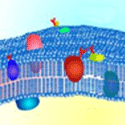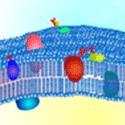Diffusion in a membrane
Understanding the Brownian motion of macromolecules embedded in a liquid membrane is important because it underlies many fundamental biological and chemical interactions. Calculations have shown that the diffusion coefficients of inclusions moving within the membrane generally increase when the thickness of the solvent on either side of the membrane increases, but this earlier work was limited either to numerical calculations or to certain limiting cases. Now, in Physical Review E, Kazuhiko Seki at the AIST in Tsukuba, Japan, and his colleagues have presented largely analytical results for diffusion coefficients that can take into account solvent layers of arbitrary thickness.
Interactions between the solvent and the membrane exert a drag force, affecting hydrodynamic flow of inclusions in the membrane. This effect may be characterized by a hydrodynamic screening length that depends on the thickness of the solvent. Seki et al. introduce an analytical expression relating diffusion coefficients to these screening lengths. For solvents of finite thickness, the equations yield multiple hydrodynamic screening lengths, together with weight factors. In some cases, only the largest hydrodynamic screening length determines diffusion coefficient, and Seki et al. have tabulated the conditions, such as the membrane and solvent viscosity, the size of the inclusion, and the solvent depth, under which this approximation holds.
This work extends previous calculations of limiting cases and clarifies the limits of their validity. Calculations such as these are becoming increasingly relevant as technological advances make it possible to observe micron-sized objects in membranes. – Margaret Foster





